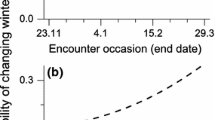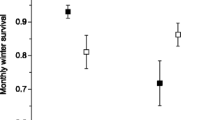Summary
This study reports an aviary experiment aimed at determining what affects social dominance in the great tit (Parus major), especially why older birds (adults) in nature normally dominate younger ones (juveniles). When birds were matched with respect to age, prior residency determined dominance. Without a difference in prior residency older birds dominated younger ones. However, when juvenile birds had a prior residency advantage over adult birds, they often became dominant. This was especially so when the juvenile bird was large relative to the adult bird. When a resident juvenile male was also consorted by a female, he became dominant over an adult male on most occasions. An experiment where the dominant bird was removed and later returned to the aviary failed to produce more than one shift in dominance. However, the proportion of reversals in dominance interactions increased with separation time. It is argued that the fact that dominance depends on prior residency selects for winter residency in the great tit.
Similar content being viewed by others
References
Arcese P, Smith JNM (1985) Phenotypic correlates and ecological consequences of dominance in song sparrows. J Anim Ecol 54:817–830
Beletsky LD, Orians GH (1989) Territoriality among male redwinged blackbirds III. Testing hypotheses of territorial dominance. Behav Ecol Sociobiol 24:333–339
Björklund M (1989) Male contests in the scarlet rosefinch (Carpodacus erythrinus) in relation to asymmetries in resource holding power and pairing status. Behav Ecol Sociobiol 25:137–140
Brawn JD, Samson FB (1983) Winter behavior of tufted titmice. Wilson Bull 95:222–232
Cheng KM, Shoffner RN, Phillips RE, Lee FB (1979) Mate preferences in wild and domesticated (game farm) mallards: II. Pairing success. Anim Behav 27:417–425
Clark GAJ (1979) Body weights of birds: a review. Condor 81:193–202
Cristol DA, Nolan VJ, Ketterson ED (1990) Effect of prior residency on dominance status of dark eyed juncos, Junco hyemalis. Anim Behav 40:580–587
Desrochers A, Hannon SJ, Nordin KE (1988) Winter survival and territory acquisition in a northern population of black-capped chickadees. Auk 105:727–736
Dhondt AA (1971) Some factors influencing territory in the great tit, Parus major L. Gerfaut 61:125–135
Drent PJ (1983) The functional ethology of territoriality in the great tit, (Parus major). PhD thesis, University of Groningen, Netherlands
Eden SF (1987) Dispersal and competitive ability in the magpie: an experimental study. Anim Behav 35:764–772
Ekman J (1989) Ecology of non-breeding social systems of Parus. Wilson Bull 101:263–288
Ekman J, Askenmo C (1984) Social rank and habitat use in willow tit groups. Anim Behav 32:508–514
Ekman J, Cederholm G, Askenmo C (1981) Spacing and survival in winter groups of willow tit, Parus montanus and crested tit, Parus cristatus — a removal study. J Anim Ecol 50:1–9
Ewald PW, Rohwer S (1980) Age, coloration and dominance in nonbreeding hummingbirds: a test of the asymmetry hypothesis. Behav Ecol Sociobiol 6:273–279
Ficken MS, Ficken RW (1967) Age-specific differences in the breeding behavior and ecology of the American redstart. Wilson Bull 79:188–189
Freeman S, Jackson WM (1990) Univariate metrics are not adequate to measure avian body size. Auk 107:69–75
Fugle GN, Rothstein SI, Osenberg CW, McGinley MA (1984) Signals of status in wintering white-crowned sparrows, Zonotrichia leucophrys gambehi. Anim Behav 32:86–97
Garnett MC (1981) Body size, its heritability and influence on juvenile survival among great tits, Parus major. Ibis 123:31–41
Hammerstein P, Parker GA (1982) The role of asymmetries in animal contests. J Theor Biol 96:647–682
Haartman L von (1968) The evolution of resident versus migratory habit in birds: some considerations. Ornis Fenn 45:1–7
Hinde RA (1952) The behaviour of the great tit (Parus major) and some other related species. Behaviour (suppl) 2:1–20
Hogstad O (1987) Social rank in winter flocks of willow tits Parus montanus. Ibis 129:1–9
Hogstad O (1989) Social organization and dominance behavior in some Parus species. Wilson Bull 101:254–263
Holbertson RL, Able KP, Wingfield JC (1989) Status signalling in dark-eyed juncos, Junco hyemalis: plumage manipulations and hormonal correlates of dominance. Anim Behav 37:681–689
Holbertson RL, Hanano R, Able KP (1990) Age-related dominance in male dark-eyed juncos: effects of plumage and prior residency. Anim Behav 40:573–580
Hyatt GW, Salmon M (1978) Combat in the fiddler crabs Uca pugilator and U. pugnax: a quantitative analysis. Behaviour 65:182–211
Järvi T, Bakken M (1984) The function of the variation in the breast stripe of the great tit (Parus major). Anim Behav 32:590–596
Järvi T, Walsö Ö, Bakken M (1987) Status signalling by Parus major: an experiment in deception. Ethology 76:334–342
Karlsson L, Persson K, Wallinder G (1986) The ringing activity at Falsterbo bird observatory in 1985. Anser 25:93–112
Ketterson ED (1979) Aggressive behavior in wintering dark-eyed juncos: determinants of dominance and their possible relation to geographic variation in sex ratio. Wilson Bull 91:371–383
Ketterson ED, Nolan V (1976) Geographic variation and its climatic correlates in the sex ratio of eastern-wintering dark-eyed juncos (Junco hyemalis hyemalis). Ecology 57:679–693
Kikkawa J (1980) Winter survival in relation to dominance classes among silvereyes Zosterops lateralis chlorocephala of Heron Island, Great Barrier Reef. Ibis 122:437–446
Knapton RW (1976) Dominance hierarchies in wintering song sparrows. Condor 78:567–569
Krebs JR (1971) Territory and breeding density in the great tit, Parus major. Ecology 52:2–22
Krebs JR (1982) Territorial defence in the great tit (Parus major): do residents always win? Behav Ecol Sociobiol 11:185–194
Laet J de (1984) Site-related dominance in the great tit Parus major major. Ornis Scand 15:73–78
Laet J de (1985) Dominance and anti-predator behaviour of great tits Parus major: a field study. Ibis 127:372–377
Lindskog H, Roos G (1979) Höststräckets förlopp hos blames, Parus caeruleus och talgoxe, Parus major vid Falsterbo 1973–1978. Anser 18:171–188
Lundberg P (1988) The evolution of partial migration in birds. TREE 3:172–175
Matthysen E (1990) Nonbreeding social organisation in Parus. In: DM Power (ed) Current ornithology. Plenum Press, New York
Maynard Smith J (1974) The theory of games and the evolution of animal conflicts. J Theor Biol 47:209–221
Maynard Smith J (1982) Evolution and the theory of games. Cambridge University Press, Cambridge
Maynard Smith J, Parker GA (1976) The logic of asymmetric contests. Anim Behav 24:159–175
Nakamura T (1975) A study of Paridae community in Japan Ill. Ecological separation in social structure and distribution. Misc Rep Yamashina Inst Ornithol 7:603–636
Nilsson J-Å (1989) Establishment of juvenile marsh tits in winter flocks: an experimental study. Anim Behav 38:586–596
Nilsson J-Å, Smith HG (1988) Effects of dispersal date on winter flock establishment and social dominance in marsh tits (Parus palustris). J Anim Ecol 57:917–928
Parker GA, Rubenstein DI (1981) Role assessment, reserve strategy, and acquisition of information in asymmetric animal conflicts. Anim Behav 29:221–240
Perrins CM (1979) British tits. Collins, London
Piper WH (1990) Site tenacity and dominance in wintering white-throated sparrows Zonotrichia albicollis (Passeriformes: Emberizidae). Ethology85:114–122
Piper WH, Wiley RH (1989) Correlates of dominance in wintering white-throated sparrows: age, sex and location. Anim Behav 37:298–310
Riechert SE (1978) Games spiders play: behavioural variability in territorial disputes. Behav Ecol Sociobiol 3:135–162
Rohwer S, Ewald PW, Rohwer FC (1981) Variation in size, appearance, and dominance within and among sex and age classes of Harris' sparrows. J Field Ornithol 52:291–303
Sabine WS (1959) The winter society of the Oregon junco: intolerance, dominance, and the pecking order. Condor 61:110–135
Saitou T (1978) Ecological study of social organization in the great tit, Parus major L. I. Basic structure of the winter flock. Jpn J Ecol 28:199–214
Saitou T (1979) Ecological study of social organization in the great Tit, Parus major L. III. Home range of the basic flocks and dominance relationship of the members in a basic flock. Misc Rep Yamashima Inst Ornithol 11:149–171
Searcey WA (1979) Morphological correlates of dominance in captive male red-winged blackbirds. Condor 81:417–420
Sherry TW, Holmes RT (1989) Age-specific social dominance affects habitat use by breeding American redstarts (Setophaga ruticilla): a removal experiment. Behav Ecol Sociobiol 25:327–333
Smith HG, Nilsson J-Å (1987) Intraspecific variation in migratory pattern of a partial migrant, the blue tit (Parus caeruleus): an evaluation of different hypotheses. Auk 104:109–115
Smith JNM, Montgomerie RD, Taitt MJ, Yom-Tov Y (1980) A winter feeding experiment on an island song sparrow population. Oecologia 47:164–170
Smith SM (1984) Flock switching in chickadees: why be a winter floater? Am Nat 123:81–98
Smith SM (1987) Responses of floaters to removal experiments on wintering chickadees. Behav Ecol Sociobiol 20:363–367
Stamps JA (1987) The effect of familiarity with a neighborhood on territory acquisition. Behav Ecol Sociobiol 21:273–277
Stamps JA, Tollestrup K (1984) Prospective resource defense in a territorial species. Am Nat 123:99–114
Svensson L (1984) Identification guide to European passerines. Svensson, Stockholm
Wiley RH (1990) Prior residency and coat-tail effects in dominance relationships of male dark-eyed juncos, Junco hyemalis. Anim Behav 40:587–597
Wilkinson L (1987) SYSTAT the system for statistics. SYSTAT, Evanston, Ill.
Yasukawa K, Bick EI (1983) Dominance hierarchies in dark-eyed juncos (Junco hyemalis): a test of a game-theory model. Anim Behav 31:439–448
Yokel DA (1989) Payoff asymmetries in contests among male brown-headed cowbirds. Behav Ecol Sociobiol 24:209–216
Author information
Authors and Affiliations
Additional information
Offprint requests to: H.G. Smith
Rights and permissions
About this article
Cite this article
Sandell, M., Smith, H.G. Dominance, prior occupancy, and winter residency in the great tit (Parus major). Behav Ecol Sociobiol 29, 147–152 (1991). https://doi.org/10.1007/BF00166490
Received:
Accepted:
Issue Date:
DOI: https://doi.org/10.1007/BF00166490




